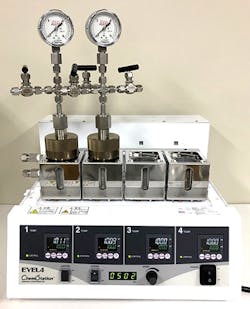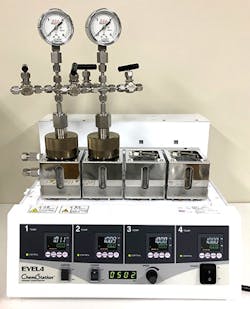Alloying Amps Up Catalyst Activity
Figure 1. Ruthenium alloyed with phosphorus provided a ten-fold increase in catalytic activity compared to unalloyed material. Source: Osaka University.
Researchers in Japan have developed a highly active and durable metal-phosphide nanoparticle (NP) catalyst for the deoxygenation of sulfoxides. Their development already has drawn interest from the pharmaceutical industry, where deoxygenation of sulfoxides is an important reaction step in the production of bioactive sulfides used in many anti-inflammatory and anti-ulcer drugs.“In particular, we are being consulted about whether catalytic reactions of complex compounds containing sulfur, such as pharmaceutical intermediates, can proceed well with metal phosphide catalysts,” explains research team member Takato Mitsudome, associate professor in the Department of Materials Engineering Science, Graduate School of Engineering Science, Osaka University, Osaka, Japan.
The team found that alloying platinum, palladium, rhodium and ruthenium with phosphorus significantly improved the catalytic activity of precious metal NPs for the deoxygenation of sulfoxides when using hydrogen. Notably, it increased the activity of ruthenium NPs ten-fold over previously reported catalysts, and also enabled them to withstand levels of sulfur that completely deactivated non-alloyed counterparts (Figure 1). Details on the research appears in a recent article in JACS Au.
Alloying involves integrating phosphorus into the metal framework of the catalyst; in reaction terms, this promotes both a ligand effect and an ensemble effect. The first is an electron transfer from the ruthenium to the phosphorus that, in turn, facilitates the heterolytic dissociation of hydrogen to produce active hydrogen species for the deoxygenation of sulfoxides. The second is a set of surface effects that suppress any strong coordination with sulfide products. Analyses revealed this dual role accounts for the enhanced catalytic activity and durability of ruthenium NPs.
Previous research by the same group found that non-precious cobalt phosphide or nickel phosphide catalysts are extremely active in industrially important selective liquid-phase molecular transformations such as transformation of biomass-derived molecules; hydrogenation of nitriles, carbonyls, nitroarenes and sulfoxides; reductive amination of carbonyls; and alkylation of oxindoles.
These earlier findings prompted the Osaka team to investigate its alloying process on the far-less-well-studied precious metal NPs.
“We expect that our metal phosphide catalyst will make a significant contribution to a lot of chemical processes which suffer from catalyst deactivation caused by sulfur. But beyond this, we believe phosphorus alloying can be a powerful method for designing highly active and durable metal nanoparticle catalysts for a variety of organic syntheses,” adds Mitsudome.

